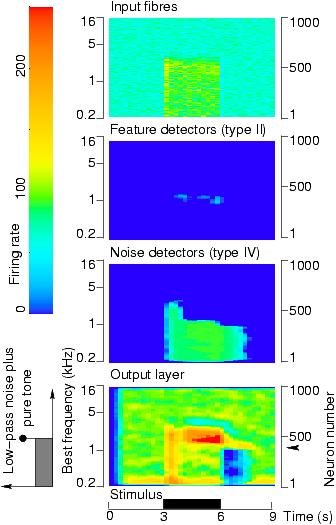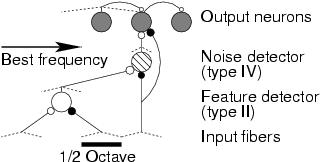
|
Zwicker Tone |

|

|
|
|
|
The Zwicker tone is a puzzling auditory illusion. It was discovered in 1964 by Eberhard Zwicker at Bell Labs and can be described as follows. A broad-band noise with a spectral gap is presented for a few seconds. On a hi-fi this would look like all the lights on your graphic equalizer are lit up except for one column in the middle. The noise is then switched off abruptly. Although there is total silence, most listeners hear a faint pure tone for up to several seconds. The pitch of the tone is perceived in the gap, where no spectral components of the stimulus were present. Until today several noise configurations have been found that all lead to a Zwicker tone but its origin has always remained unclear. We now provide a neuronal model that can explain the Zwicker tone illusion. Suppression of background noise is the key ingredient in generating the effect (J.M.P. Franosch et al., Physical Review Letters 2003). The Zwicker tone as a transient auditory sensation is often thought of as a short-term tinnitus, the familiar ringing in the ears after a rock concert. Tinnitus is also a very irritating medical condition. We show how the Zwicker tone provides novel insight as to how tinnitus might be the result of persistent activation of a noise-reduction mechanism.
References Jan-Moritz P. Franosch, Richard Kempter, Hugo Fastl and J. Leo van Hemmen. Zwicker Tone Illusion and Noise Reduction in the Auditory System. Phys. Rev. Lett. 90:178103 (2003) ( PDF 166 KB , PS GZip 539 KB )
Rauschen mit Nachhall - Hörillusion aufgeklärt, Süddeutsche
Zeitung, 20.5.2003
Zwicker-Ton, Rauschunterdrückung und Tinnitus
Computersimulationen versprechen neuen Ansatz zur Behandlung von Tinnitus
Ghosts of sounds may give hints about tinnitus
Dem "Sprechen mit den Göttern" auf der Spur, Baseler Zeitung,
4.7.2003
Tintinnius, un'illusione uditiva
last modified 2007-11-05 by webmaster@Franosch.org |
 Numerical simulation of a Zwicker tone. Firing rates (color coded)
of 1000 output neurons are a funtion of time and the neurons' best
frequency. Feature detectors respond to the pure tone, causing a
"hole burning" in the noise-detector layer. This mechnism finally
generates the Zwicker tone. The Zwicker tone is perceived below
the pure tone and is indicated by an arrow head, pointing at the
yellow strip of activity in the output layer.
Numerical simulation of a Zwicker tone. Firing rates (color coded)
of 1000 output neurons are a funtion of time and the neurons' best
frequency. Feature detectors respond to the pure tone, causing a
"hole burning" in the noise-detector layer. This mechnism finally
generates the Zwicker tone. The Zwicker tone is perceived below
the pure tone and is indicated by an arrow head, pointing at the
yellow strip of activity in the output layer.
 The neuronal network used in the simulation. Circles denote
neurons, small filled circles indicate excitatory and small open
circles inhibitory synapses. The feature detectors are active, if
there is a steeply rising edge, i.e., a rising spectral intensity
as frequency increases. Feature detectors inhibit noise detectors,
which, in turn, inhibit corresponding output neurons. The Zwicker
tone is finally generated by the lateral inhibition in the output
layer.
The neuronal network used in the simulation. Circles denote
neurons, small filled circles indicate excitatory and small open
circles inhibitory synapses. The feature detectors are active, if
there is a steeply rising edge, i.e., a rising spectral intensity
as frequency increases. Feature detectors inhibit noise detectors,
which, in turn, inhibit corresponding output neurons. The Zwicker
tone is finally generated by the lateral inhibition in the output
layer.





